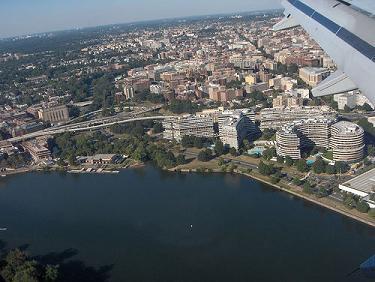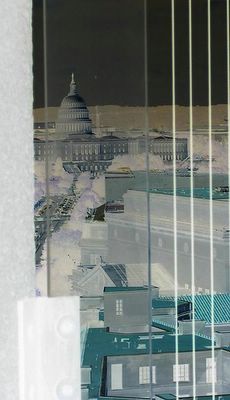ARCHITECTURE: A City of Facades
Good morning. Finally the work week has ended and I now have a little more time to spend blogging today. But not too much time however. I'll be starting the process of moving things out of my kitchen and bathroom which will be renovated next week. I'll be moving into temporary exile in the Palisades. So if you see me on the D6 or M4 bus, say hello. My Internet access, however, will be limited. But I'll be back at it around Halloween.
 1.) ONE OF THE WATERGATE'S office buildings was sold to a Los Angeles-based real estate company for $86 million earlier this week. You can read details of the sale from The Washington Post's article on Trizec Properties Inc.'s sale to BentleyForbes LLC here.
1.) ONE OF THE WATERGATE'S office buildings was sold to a Los Angeles-based real estate company for $86 million earlier this week. You can read details of the sale from The Washington Post's article on Trizec Properties Inc.'s sale to BentleyForbes LLC here. The office building in question is 2600 Virginia Ave. NW, the one facing the old Howard Johnson's ... the Watergate office building of Watergate fame. Unlike the graceful curving co-ops fronting the Potomac River, New Hampshire Avenue and Benito Juarez's statue, the building BentleyForbes just purchased is perhaps the least-interesting architecturally, at least its exterior. It's the interior that is important and BentleyForbes' president, David W. Cobb, tells the Post's Dana Hedgpeth that there will be some updates: "We're going to update the elevators, spruce it up. We're going to try to keep more of the original aesthetics but update it and make it a little bit nicer."
For such an interesting building, I hope a nice balance of new and old can be achieved. Washington's track record in gutting buildings in favor of renovating interior spaces has not been all that great -- or has been totally awesome -- depending on your outlook on preservation. Look at two examples on 15th Street NW between the White House and McPherson Square. The guts of the old Bowen Building (part of the Kaempfer Co.'s portfolio, which is part of Vornado) were ripped out and rebuilt anew, its facade is the only thing that remains original. Down the block, the Woodward Building will meet the same fate. This Post article gives an interesting look into the unique time machine that is the Woodward Building. But SJG Properties has other plans. The bikini shop must go.
Granted, modern office space is necessary to make buildings profitable. Everything historic can't endure. This quote regarding the Bowen Building from the Washington Business Journal says quite a lot:
"D.C.'s running out of developable space," said Richard Naing, senior vice president for the private markets group of CB Richard Ellis. "That's the beauty of this project because you can make it whatever you want."Mr. Naing is quite right. Washington is running out of downtown commercial space. But aren't there just a few too many Ann Taylor Lofts in the world? Just because you "can make it whatever you want" shouldn't mean that a good old rehabbed building should be filled with default examples of glorified mediocrity. Do something that's interesting and forward-thinking, don't do something that's standard, just to maximize an already guarenteed profit. (If Morris Cafritz, the pioneer of modern K Street, were still living, I'm curious what he would think of today's office environment in D.C.)
The artform of ripping out interiors is something that Washington does quite well. Remember, the majority of the White House residence is only 50-some years old.
 During the Truman administration, the original 1792 residence was in such bad shape after decades of abuse and renovation that it had to be gutted and rebuilt with a steel skeleton (at right). So I would discourage you to view think that the spirit of Abraham Lincoln is strolling the halls of the building pondering the Emancipation Proclamation. Abe's ghost was kicked out, but probably wasn't afforded temporary quarters at Blair House during the executive mansion's rehabbing.
During the Truman administration, the original 1792 residence was in such bad shape after decades of abuse and renovation that it had to be gutted and rebuilt with a steel skeleton (at right). So I would discourage you to view think that the spirit of Abraham Lincoln is strolling the halls of the building pondering the Emancipation Proclamation. Abe's ghost was kicked out, but probably wasn't afforded temporary quarters at Blair House during the executive mansion's rehabbing.Then I suggest you look at JonesLangLaSalle's 2000 Pennsylvania Avenue complex (warning, annoying Flash animation). It has the awfully quaint set of rowhouses on its I Street front. Those houses are the symbol for the massive shopping complex that sits behind it.
 According to its online promotion, it's "Where the Neighborhood Shops." That slogan is just slightly offensive, because these days the neighborhood's residents consist of Nassau County undergrads at George Washington University and International Monetary Fund/World Bank daytime office workers. And I have never seen anyone dribble a basketball down I Street on their way to Bertucci's while talking on their cellphone, as the Flash animation might imply. Perhaps I'm just slightly bias because the center rowhouse in the graphic once belonged to my family. It's where Grandpa Grass and my great uncle, both deceased, lived in the last century. My great aunt grew up a few rowhouses down the block closer to 21st Street NW.
According to its online promotion, it's "Where the Neighborhood Shops." That slogan is just slightly offensive, because these days the neighborhood's residents consist of Nassau County undergrads at George Washington University and International Monetary Fund/World Bank daytime office workers. And I have never seen anyone dribble a basketball down I Street on their way to Bertucci's while talking on their cellphone, as the Flash animation might imply. Perhaps I'm just slightly bias because the center rowhouse in the graphic once belonged to my family. It's where Grandpa Grass and my great uncle, both deceased, lived in the last century. My great aunt grew up a few rowhouses down the block closer to 21st Street NW. Don't get me wrong, it is nice to have the city's streetscape preserved. But in one way, the ripping out of Washington's interior spaces is quite representative of our city: We care more about the facades -- our public face -- than care about the substance of what is inside. In a city and metropolitan area that has a sizable modern population of outsiders, it's easier to perform an architectural vivisection on a building's history when you don't have roots here. This is happening to many rowhouses in Columbia Heights, because it is considerably easier to live with a nice Corian-topped kitchen counter than contend with sagging wooden floors and a hissing century-old radiator. (It also helps your property values.) You couldn't have modern Washington, without having modern office space. It's just too bad that we can't have a better balance.
 I hope to follow the plans of how Bentley Forbes proceeds with its renovations. There are so many opportunities to rejuvenate such a cool retro space like the Watergate. My favorite example is out at National Airport, where the original 1941 Art Deco/Streamlined Moderne terminal has been spruced up, which connects today's Terminal A and Terminal B. But the terminal is more of a deserted museum. Wouldn't it be cool if you could board a plane from an Art Deco lobby? At least it's open to the public. That space should see life again.
I hope to follow the plans of how Bentley Forbes proceeds with its renovations. There are so many opportunities to rejuvenate such a cool retro space like the Watergate. My favorite example is out at National Airport, where the original 1941 Art Deco/Streamlined Moderne terminal has been spruced up, which connects today's Terminal A and Terminal B. But the terminal is more of a deserted museum. Wouldn't it be cool if you could board a plane from an Art Deco lobby? At least it's open to the public. That space should see life again. -- Aerial view of the Watergate from Flickr's Esthr.
-- Image of the gutted White House from the Truman Library
-- Image of historic Terminal A from the Metropolitan Washington Airport Authority via the U.S. Centennial of Flight Commission




